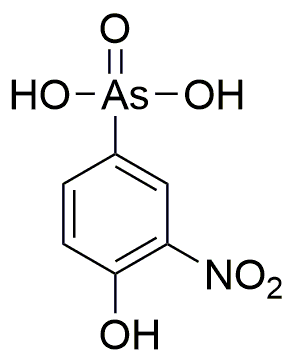4-Hydroxy-3-nitrophenylarsonic acid is widely utilized in research focused on:
- Agricultural Chemistry: This compound is used as a herbicide to control unwanted vegetation in crops, enhancing agricultural productivity while minimizing chemical runoff.
- Pharmaceutical Development: It serves as a precursor in the synthesis of various pharmaceutical agents, particularly in the development of drugs targeting specific diseases.
- Environmental Monitoring: The compound is employed in analytical chemistry for detecting arsenic levels in environmental samples, helping to ensure compliance with safety regulations.
- Material Science: It is used in the formulation of specialized coatings and materials, providing enhanced durability and resistance to environmental factors.
- Biochemical Research: Researchers utilize this compound in studies related to cellular processes and toxicology, aiding in the understanding of arsenic's effects on biological systems.
General Information
Properties
Safety and Regulations
Applications
4-Hydroxy-3-nitrophenylarsonic acid is widely utilized in research focused on:
- Agricultural Chemistry: This compound is used as a herbicide to control unwanted vegetation in crops, enhancing agricultural productivity while minimizing chemical runoff.
- Pharmaceutical Development: It serves as a precursor in the synthesis of various pharmaceutical agents, particularly in the development of drugs targeting specific diseases.
- Environmental Monitoring: The compound is employed in analytical chemistry for detecting arsenic levels in environmental samples, helping to ensure compliance with safety regulations.
- Material Science: It is used in the formulation of specialized coatings and materials, providing enhanced durability and resistance to environmental factors.
- Biochemical Research: Researchers utilize this compound in studies related to cellular processes and toxicology, aiding in the understanding of arsenic's effects on biological systems.
Documents
Safety Data Sheets (SDS)
The SDS provides comprehensive safety information on handling, storage, and disposal of the product.
Product Specification (PS)
The PS provides a comprehensive breakdown of the product’s properties, including chemical composition, physical state, purity, and storage requirements. It also details acceptable quality ranges and the product's intended applications.
Certificates of Analysis (COA)
Search for Certificates of Analysis (COA) by entering the products Lot Number. Lot and Batch Numbers can be found on a product’s label following the words ‘Lot’ or ‘Batch’.
Número de catálogo
Número de lote/lote
Certificates Of Origin (COO)
This COO confirms the country where the product was manufactured, and also details the materials and components used in it and whether it is derived from natural, synthetic, or other specific sources. This certificate may be required for customs, trade, and regulatory compliance.
Número de catálogo
Número de lote/lote
Safety Data Sheets (SDS)
The SDS provides comprehensive safety information on handling, storage, and disposal of the product.
DownloadProduct Specification (PS)
The PS provides a comprehensive breakdown of the product’s properties, including chemical composition, physical state, purity, and storage requirements. It also details acceptable quality ranges and the product's intended applications.
DownloadCertificates of Analysis (COA)
Search for Certificates of Analysis (COA) by entering the products Lot Number. Lot and Batch Numbers can be found on a product’s label following the words ‘Lot’ or ‘Batch’.
Número de catálogo
Número de lote/lote
Certificates Of Origin (COO)
This COO confirms the country where the product was manufactured, and also details the materials and components used in it and whether it is derived from natural, synthetic, or other specific sources. This certificate may be required for customs, trade, and regulatory compliance.


